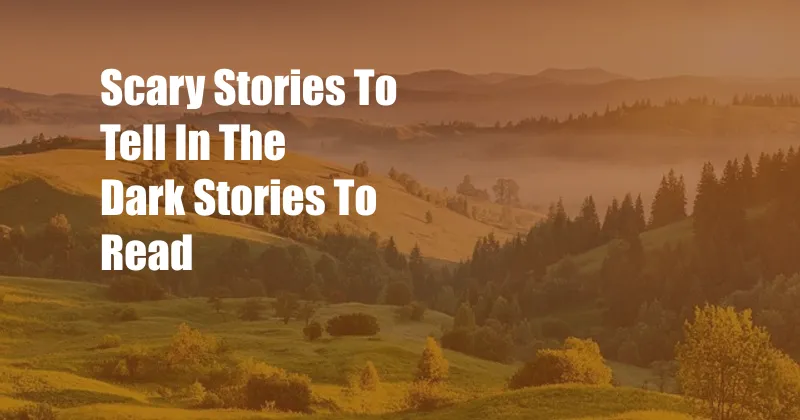
Scary Stories to Tell in the Dark: Unraveling the Shadows
In the realm of spine-tingling tales, “Scary Stories to Tell in the Dark” stands as a timeless masterpiece that has captured the imaginations of generations. From the eerie folklore of Alvin Schwartz to the chilling adaptations by Stephen Gammell, these stories have woven a web of darkness that lingers in our minds long after the pages are turned.
As a child, I stumbled upon this book in an old library, its worn cover and faded illustrations hinting at the unsettling secrets within. Curiosity quickly turned to trepidation as I ventured into the world of “The Red Spot,” “Harold,” and “The Dead Man’s Float.” Each story was a haunting melody, its notes ringing through the corridors of my childhood nightmares.
The Power of Darkness: Exploring the Macabre
What is it about the dark side that fascinates us so? Perhaps it is the thrill of confronting our fears, of peeking into the abyss and emerging unscathed. Or maybe it’s the allure of the inexplicable, the unknown forces that lurk just beyond our comprehension.
Scary stories have always held a special place in our culture. They serve as a way to explore our darkest impulses, to delve into the depths of human nature. From ancient campfire tales to modern horror films, these stories help us to confront the terrors that haunt our collective imagination.
The Historical Tapestry of Scary Stories
The tradition of scary stories spans civilizations and centuries. In ancient Greece, the tales of Homer and Sophocles were filled with supernatural beings and tragic heroes. During the medieval period, folklore flourished, weaving together legends of dragons, werewolves, and witches.
In the 18th and 19th centuries, Gothic literature emerged, bringing a new level of sophistication to the genre. Authors such as Edgar Allan Poe and Mary Shelley explored the psychological and emotional aspects of fear, creating haunting and unforgettable characters.
“Scary Stories to Tell in the Dark”: A Modern Classic
First published in 1981, “Scary Stories to Tell in the Dark” is a collection of folklore from around the world, meticulously compiled by Alvin Schwartz. The book’s unique charm lies in its simplicity and authenticity. Schwartz’s retellings are stripped down to their bare essentials, allowing the raw power of the stories to shine through.
Stephen Gammell’s eerie illustrations perfectly complement the text. His pen-and-ink drawings capture the essence of each story, adding an unsettling visual dimension that lingers in the reader’s mind long after the book is closed.
The Enduring Legacy of “Scary Stories to Tell in the Dark”
The impact of “Scary Stories to Tell in the Dark” has been profound. The book has been translated into dozens of languages and has sold millions of copies worldwide. It has been adapted into a successful television show and a feature film, introducing new generations to the timeless art of storytelling.
But more than its commercial success, “Scary Stories to Tell in the Dark” has left an indelible mark on the cultural landscape. It has inspired countless writers, filmmakers, and artists to explore the dark side of human nature. And it has instilled in generations of readers a lifelong love of the macabre, reminding us that the realm of shadows can both terrify and enthrall.
Tips for Writing Effective Scary Stories
If you’re aspiring to write your own spine-tingling tales, here are a few tips to keep in mind:
- **Create a sense of atmosphere:** Setting the right atmosphere is crucial. Use sensory details to evoke a mood of foreboding and unease.
- **Develop believable characters:** Readers need to connect with the characters in your story. Give them relatable fears and motivations.
- **Build suspense gradually:** Don’t rush into the scares. Let the tension build slowly, layer by layer.
- **Use vivid imagery:** Fear is heightened when it is vividly depicted. Paint a picture in the reader’s mind that they won’t soon forget.
- **Leave room for interpretation:** The most terrifying stories are often the ones that leave room for the reader’s imagination.
Remember, writing scary stories is an art form. Experiment with different techniques, find your own voice, and let your dark side shine through.
FAQs on “Scary Stories to Tell in the Dark”
Q: What is the age-appropriateness of “Scary Stories to Tell in the Dark”?
A: The book is recommended for readers aged 8 and up. However, some of the stories may be too intense for younger or more sensitive readers.
Q: Are the stories in “Scary Stories to Tell in the Dark” true?
A: No, the stories are fictional, although they are based on folklore and legends from around the world.
Q: Is there a movie adaptation of “Scary Stories to Tell in the Dark”?
A: Yes, a feature film adaptation was released in 2019, directed by André Øvredal.
Conclusion
In the annals of the macabre, “Scary Stories to Tell in the Dark” stands as a timeless masterpiece, its chilling tales echoing through generations. From its humble origins in folklore to its enduring legacy in modern culture, this book has captivated readers with its ability to tap into our deepest fears and darkest desires.
So, if you dare to venture into the realm of shadows, let “Scary Stories to Tell in the Dark” be your guide. Prepare yourself for a heart-pounding experience that will leave you both terrified and exhilarated.
Are you a fan of scary stories? Share your own experiences and recommendations in the comments section below.